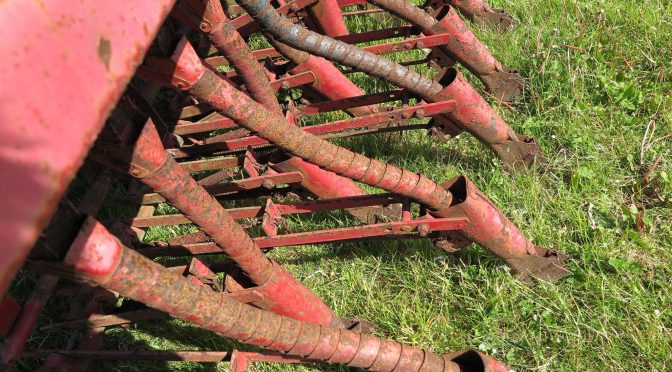If you were looking to buy a new corn and seed drill in 1952 you would have had a number of machines to choose from which were made by a range of makers in Scotland, England and Ireland.
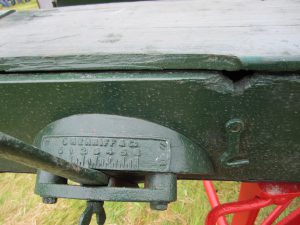 By this time there were, however, only a small number of Scottish makers. If you had been purchasing a machine in 1910 you could have chosen one from makers including George Sellar & Son, Huntly, Thomas Sherriff & Co., West Barns, Thomas Turnbull, Dumfries, Kemp & Nicholson, Stirling, Bon Accord Engineering Co. Ltd, Aberdeen, and Robert G. Garvie, Aberdeen. They provided a network of sowing machine makers throughout the country.
By this time there were, however, only a small number of Scottish makers. If you had been purchasing a machine in 1910 you could have chosen one from makers including George Sellar & Son, Huntly, Thomas Sherriff & Co., West Barns, Thomas Turnbull, Dumfries, Kemp & Nicholson, Stirling, Bon Accord Engineering Co. Ltd, Aberdeen, and Robert G. Garvie, Aberdeen. They provided a network of sowing machine makers throughout the country.
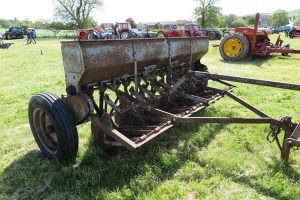 In 1952 the most important Scottish maker was Thomas Sherriff & Co. Ltd, a long-established maker from 1816. Its grain drills included a horse drawn drill with 14 or 16 rows and a 6 inch coulter. It made two tractor drawn drills, one with 16 rows, the other with 20 rows. Both had a 6 inch coulter and rear foot boards. The other maker was McCartney & Miller, Bridgend, Ceres, Fife. It manufactured a 3-row replacement drill which was driven by a land wheel.
In 1952 the most important Scottish maker was Thomas Sherriff & Co. Ltd, a long-established maker from 1816. Its grain drills included a horse drawn drill with 14 or 16 rows and a 6 inch coulter. It made two tractor drawn drills, one with 16 rows, the other with 20 rows. Both had a 6 inch coulter and rear foot boards. The other maker was McCartney & Miller, Bridgend, Ceres, Fife. It manufactured a 3-row replacement drill which was driven by a land wheel.
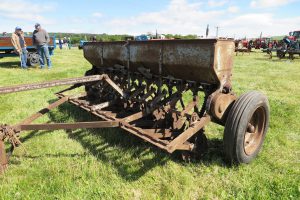 The English makers included some of the long-established seed drill makers such as Harrison, McGregor & Guest Ltd, Albion Iron Works, W. Rainforth & Sons, Lincoln, and Walter A. Wood Co. Ltd, Horsham, Sussex. From Ireland was Philip Pierce & Co. Ltd, Wexford, Eire, with its “Victor” tractor drawn, land wheel driven drill with from 11 to 15 rows, and Wexford Engineering Co. Ltd, Wexford, with its range of 11, 13 or 15 row machines for horse or tractor, with sowing widths from 4 feet 4 inch to 6 feet 6 inch.
The English makers included some of the long-established seed drill makers such as Harrison, McGregor & Guest Ltd, Albion Iron Works, W. Rainforth & Sons, Lincoln, and Walter A. Wood Co. Ltd, Horsham, Sussex. From Ireland was Philip Pierce & Co. Ltd, Wexford, Eire, with its “Victor” tractor drawn, land wheel driven drill with from 11 to 15 rows, and Wexford Engineering Co. Ltd, Wexford, with its range of 11, 13 or 15 row machines for horse or tractor, with sowing widths from 4 feet 4 inch to 6 feet 6 inch.
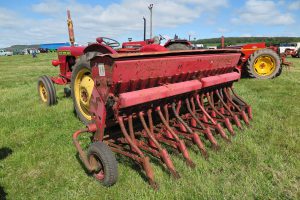 The tractor makers were starting to make important inroads into the manufacture of drills. Harry Ferguson Ltd, Coventry, made a 13 row trailed drill with a hydraulic hitch attachment for one of its tractors, to which a fertiliser distributor could be attached.
The tractor makers were starting to make important inroads into the manufacture of drills. Harry Ferguson Ltd, Coventry, made a 13 row trailed drill with a hydraulic hitch attachment for one of its tractors, to which a fertiliser distributor could be attached.
There were also other English names, some well-known, others not so. They generally made either horse or tractor driven drills. The James Clay (Wellington) Ltd, Wrekin Foundry, Ketley, Salop, had a 13 row coulter drill for corn with an overall width of 7ft 9ins, and a disc drill of either 13 or 16 rows with a width of 8ft 3 ins or 9ft 9 ins. Denning & Chard & Co. (1937) Ltd, Chard, had a tractor drawn, force feed, 12 row machine with a width of 8ft 9 ins. W. T. Teague (Machinery) Ltd, Blackwater, Truro, Cornwall, had a drill with fertiliser placement.
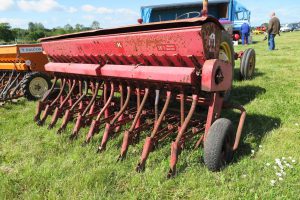 If you were looking for a drill for horticultural use, you could purchase one from Jalp Products Ltd, Wimborne, Dorset.
If you were looking for a drill for horticultural use, you could purchase one from Jalp Products Ltd, Wimborne, Dorset.
By 1952 seed drill making in Scotland was not a major activity for the implement and machine makers. If you were a farmer or agriculturist you had to look further afield, unless, of course, you wanted a machine from the most eminent maker in Scotland: Thomas Sherriff & Co., West Barns.
The photos of seed drills was taken at the Fife Vintage Agricultural Machinery rally, June 2012, and June 2015.
